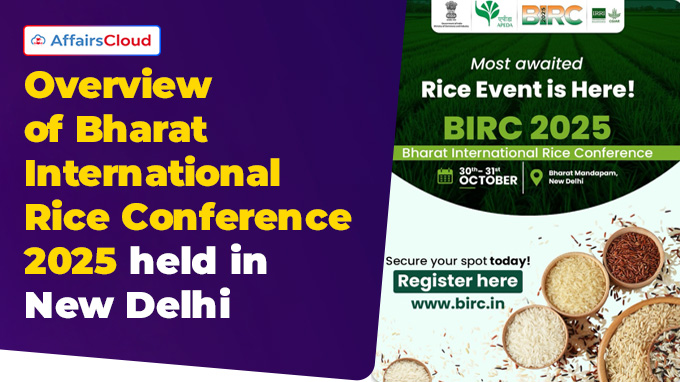The Bharat International Rice Conference (BIRC 2025), the world’s largest platform dedicated to the rice industry, was held at Bharat Mandapam in New Delhi, Delhi from October 30 to October 31, 2025.
- The two-day conference was chaired by Union Minister Piyush Goyal, Ministry of Commerce & Industry(MoC&I), Ministry of Consumer Affairs, Food & Public Distribution(MoCAF&PD), brought together stakeholders from over 80 countries, including exporters, importers, policymakers, and technology leaders, to discuss the future of India’s rice trade and agri-innovation.
Exam Hints:
- Event: Bharat International Rice Conference (BIRC 2025)
- Held at: Bharat Mandapam in New Delhi, Delhi
- Co-organisers: Indian Rice Exporters’ Federation (IREF) and (APEDA) under MoC&I (provided the non-financial support)
- Key Supporters:
- Ministries/Departments: DARE under MoA&FW, MoFPI, and MoCAF&D
- State Governments: Odisha, Telangana, Meghalaya, Assam and Manipur
- Other Indian Institutions: ICAR, NCEL, NCOL, among others.
- Key Highlights:
- Launch of India’s 1st AI-based rice sorting system;
- Signing of MoUs worth Rs.3000 crore on day 1 and Rs 30,435 crore on day 2;
- Felicitation of several Indian Farmers
- Release of Coffee Table Book on Indian rice varieties
- Key Rice Data: India produced 150 MT of rice in 2024–25 (28% of global output); exports worth USD 12.95 billion to 172 countries.
About BIRC 2025:
Key Target: The conference aims to tap Rs 1.80 lakh crore in new rice import markets, and sign exports MoUs worth Rs 25,000 crore.
Organiser: BIRC 2025 was organised by the Indian Rice Exporters’ Federation (IREF), apex body of rice which represents more than 75,000 exporters and allied stakeholders in India; in collaboration with the Agricultural and Processed Food Products Export Development Authority (APEDA) under the Ministry of Commerce & Industry (MoC&I), which provided the non-financial support to the event.
Partners: The Rice Exporters Association, Chhattisgarh (TREA-CG) and the Rice Exporters Association (TERA), Kakinada, Andhra Pradesh(AP) were the co-partners of the event.
- The International Rice Research Institute – South Asia Regional Centre (IRRI-SARC), Varanasi, serves as the research and knowledge partner for the event, with E&Y (Ernst & Young) and S&P Global (Standard & Poor’s Global) as additional knowledge partners.
- The event was supported by countries like: Gambia, Niger, Liberia, Jordan, Sierra Leone, Comoros, Somalia and Myanmar.
Key Supporters: The conference received the support from various union ministries, departments such as: Department of Agricultural Research and Education (DARE), Ministry of Agriculture & Farmers Welfare (MoA&FW), Ministry of Food Processing Industries (MoFPI), and Ministry of Consumer Affairs, Food & Public Distribution (MoCAF&D).
- State Governments: The event was also supported by various state governments: Odisha, Telangana, Meghalaya, Assam and Manipur. Each participating state brought their unique agricultural identity for instance: Assam’s heritage of aromatic Joha and Bao rice; Meghalaya’s climate resilient and community driven farming, among others.
- Other Indian Institutions: Indian Council of Agricultural Research (ICAR), National Cooperative Exports Limited (NCEL), National Cooperative Organics Limited (NCOL), among others.
Key Participants: The conference witnessed the participation of 10,854 visitors which included 1,083 global buyers and 154 exhibitors from across the country.
Highlights of BIRC 2025:
India’s first AI-based rice sorting system:
Launch: The event featured a dedicated ‘AgriTech Pavilion’ showcasing India’s first Artificial Intelligence(AI)-based rice sorting technology, launched live during the inaugural session, marking a major step toward next-generation agricultural precision.
Features: This new system, supported by AI and Big Data, can simultaneously analyze the color, shape, size, and structure of rice grains, providing unprecedented precision and efficiency while reducing cost, power consumption, and manpower.
Key Sessions: The conference included 8 sessions on Global Rice Market Evolution; Shipping Logistics for Rice Trade; Improving Rice Agriculture and Nutrition; Value Addition in Rice; Quality Certification and Food Safety; Organic Rice and Related Goods; Logistics, Credit, and Insurance covers; and role of rice in achieving Viksit Bharat 2047.
- During the session, a platform was introduced to launch the Vision & Roadmap for India’s rice sector, which will be developed within six months by the Department of Commerce(DoC) under the MOC&I in collaboration with various Ministries, and State Governments, integrating insights from experts, policymakers, and industry leaders.
MoUs Signed:
MoU: On Day 1, Memorandums of Understanding (MoUs) worth over Rs.3,000 crore were signed, including Rs.2,200 crore facilitated by the government with private firms in Bihar for Geographical Indication (GI) rice varieties like Katarni, along with other agreements between Indian and foreign rice companies.
- On Day 2, MoUs worth Rs 30,435 crore, which highlights the growing global confidence in India’s rice sector.
Incubation & Research Centre: During the event, a contract was signed to set up an Agricultural Research Centre in New Delhi focused on sustainable and climate-resilient rice production, seed innovation, and post-harvest research.
Agri Placement MoUs: The agreements were also signed to provide R&D placements for agricultural graduates, boosting innovation and employment in the agri-research sector.
Felicitation of Farmers:
Felicitation: During BIRC 2025, several farmers from across India were honoured by global buyers for their outstanding contributions to quality, innovation, and sustainability in rice cultivation.
Recognised Farmers :
- Anand Malik (from West Bengal, WB) for Gobinddobhog rice;
- Surendra Masti (from Odisha) for Kalajeera-Koraput rice;
- Manjul Pratap Singh and Ajay Singh (from Uttar Pradesh, UP) for Type-3 Dehradhuni Basmati;
- Zafar Ahmad Bhat (from Jammu & Kashmir, J&K) for Mushkbudji rice;
- Khangenbam Shamusaba Singh (from Manipur) for Chak Hao black rice;
- Mahan Chandra Borah (from Assam) for Joha rice;
- Subodh Choudhary (from Bihar) for Katarni rice;
- Janardanan Karoth Veetil and Indira P (from Kerala) for Kaipad rice;
- Banamali Pujari (from Odisha) and Kochu Kumar (from Kerala) for Indrani rice, among others.
Other Key highlight:
Pavilions: A Special Women Entrepreneurs, Startups, and Micro, Small and Medium Enterprises (MSME) Pavilion was organised to highlight innovation across the agri-value-chain i.e. from seed development and post-harvest technologies to packaging, branding, digital trade, among others.
- State and Union Territory(UT) Pavilions from J&K, Manipur, Telangana, Odisha, Meghalaya, Assam, UP, Bihar, Chhattisgarh, and Haryana showcased GI and specialty rice varieties, sustainable farming practices, processing facilities, logistics, investments, and buyer-connect initiatives.
Launch of Bharat Organics’ Organic Rice Range: Under the aegis of the National Cooperative Organics Limited (NCOL), Bharat Organics launched its Organic Rice Range and Direct-to-Consumer (D2C) platform at BIRC 2025.
- The lineup features two flagship variants: Traditional Basmati and Traditional Brown Basmati; along with ten single-origin varieties, including Kala Namak (Uttar Pradesh, UP), Indrayani (Maharashtra), Gobindobhog (West Bengal, WB), Black Rice (Manipur), and Red Matta (Kerala).
Coffee Table Book: On the concluding day, a coffee table book showcasing India’s rich rice heritage was unveiled.
Key Rice Sector Highlights:
India’s Production Share: India produced around 150 million tonnes(MT) of rice in 2024–25 from nearly 47 million hectares, representing about 28% of the world’s total rice output.
Rising Productivity:Average rice yields improved from 2.72 tonnes per hectare in 2014–15 to approximately 3.2 tonnes per hectare(t/ha) in 2024–25, supported by enhanced seed varieties, advanced agronomic practices, and wider irrigation coverage.
Export Performance: During FY 2024–25, India exported 20.1 million metric tonnes of rice worth around USD 12.95 billion, supplying to more than 172 countries across the globe.
Major Importers: Key markets with high potential for Indian rice exports include Indonesia (USD 2,586 mn), Philippines (USD 2,470 mn), Saudi Arabia (USD 497 mn), Vietnam (USD 1,463 mn), and Iraq (USD 1,661 mn).
Economic Significance: Valued at approximately USD 330 billion, the global rice industry stands as the third most-traded food commodity worldwide.
About Indian Rice Exporters’ Federation (IREF):
President- Prem Garg
Headquarters- New Delhi, Delhi
Established- 2023





